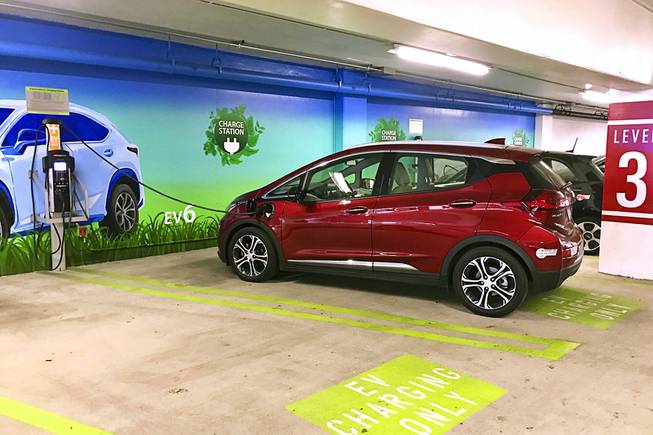
Ronald Montoya / Edmunds via AP
This undated photo shows a 2017 Chevrolet Bolt at a charging station in a shopping mall parking lot. You’ll want to coordinate your charges with other activities to help pass the time.
Monday, May 20, 2019 | 2 a.m.
A popular selling point for electric vehicles is the notion that you never have to stop for gas. Your "gas station" is in your garage — simply plug in your vehicle to charge it overnight.
But what if you live in an apartment? Or park somewhere without a plug? How practical is it to own an electric vehicle if you can't charge it at home?
I set out to answer these questions by driving two electric vehicles in the Edmunds test fleet without relying on a home- or office-based charger. I spent one week in a Chevrolet Bolt and another in a Tesla Model 3. The Bolt has an estimated driving range of 238 miles on a full charge, and the Model 3 Long Range can go an EPA-estimated 310 miles. Here are a few lessons I learned along the way.
FIND A STATION AND ROUTINE THAT WORKS FOR YOU
Without a home charger, you'll need to rely on public stations. But locating them can be challenging, even when you know the exact address. Some are located in shopping mall parking lots, while others might be at hotels or car dealerships. Sometimes, you'll have to pay for parking.
Based on my 40-mile commute and weekend mileage in the Los Angeles area, I knew I'd need to charge the Bolt every two or three days for about three hours, which meant finding a charge station near whatever I planned on doing. One night I went to see a movie and used the charging station in a mall parking lot. It was reasonably convenient. But on another day, the closest charger was a 0.75-mile walk from the barbecue I was attending.
Recharging was easier with the Tesla Model 3. Its greater range meant I could drive longer before needing to stop to recharge. Also, Telsa's exclusive Supercharger stations were in more obvious locations, and their fast charging speeds meant less downtime.
HAVE A BACKUP CHARGING STATION IN MIND
For EVs other than a Tesla, you'll have to set up an account with one or more of the major charge station companies such as ChargePoint, Blink or EVgo. Their respective smartphone apps do an excellent job of helping you locate the charging stations in your area, along with showing how many spaces are currently in use.
The trouble is, by the time you get there, the spaces might be occupied — sometimes even by a non-EV owner who wasn't paying attention to the signs. At that point, you can either wait — which can take anywhere from a few minutes to a few hours, depending on the charger and vehicle — or try another nearby station.
It's much less of an issue for a Tesla Supercharger station, which can typically accommodate a dozen cars at once.
KEEP BATTERY TOPPED OFF
Let's say you get lazy or have a busy week and don't have time to charge on your normal schedule. If you run the battery low in the Bolt, for example, you're looking at an estimated eight- to nine-hour charge at a Level 2 charger to fill it back to 100%.
Charging times aren't much of an issue on the Model 3 provided you have access to a Supercharger station. These stations can quickly recharge a nearly depleted battery to about 80% capacity, which is good for more than 200 miles of driving, in about 20-30 minutes.
The Supercharger equivalent for non-Teslas is a Level 3 charger, or DC fast charger. However, there's less consistency — some stations might not always be that fast. I learned this when I visited a Level 3 station in the Bolt with a nearly drained battery. After 30 minutes, I only had gained 34 miles of range.
BE PREPARED FOR VARYING ELECTRICITY COSTS
Sometimes, you'll be able to find a free public-access charger. But for the most part, you'll have to pay to recharge. And just like with gas stations, the price varies. A kilowatt-hour of electricity is based on the utility rates in that city and the price the station owner set for that machine. For example, a 3 1/2-hour charge (good for about 120 miles of range) in the Bolt cost $3.54 in one place and $6.52 at a different location I used later in the week.
Pricing for Level 3 chargers can be even more expensive. Tesla's Supercharger network has a fixed cost of 28 cents per kilowatt-hour, allowing you to better plan for recharging expenses.
EDMUNDS SAYS: It is possible to own an EV without a home charger. But it depends on how much you drive daily and how comfortable you are with sticking to a routine of public charging, which is easier with Tesla's supercharging network. However, the barrier of entry for Teslas is higher given that they are more expensive than the average EV.
This story was provided to The Associated Press by the automotive website Edmunds. Ronald Montoya is a senior consumer advice editor at Edmunds.
